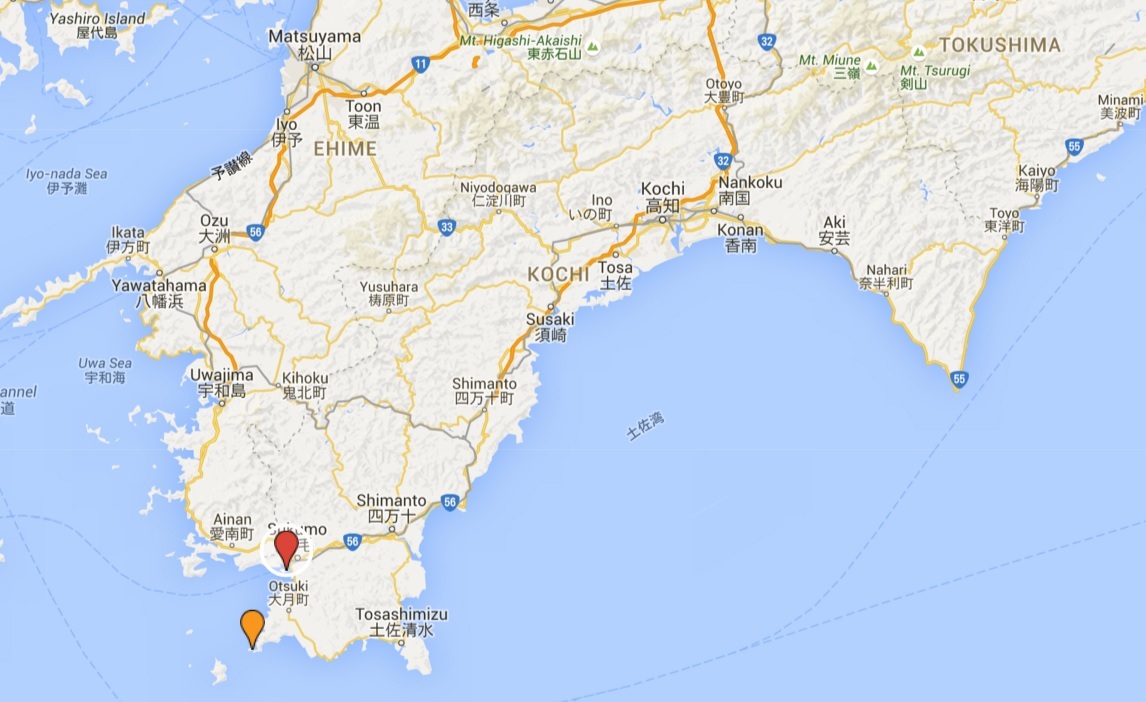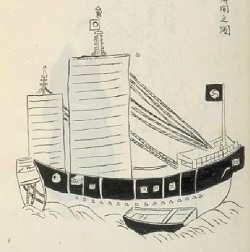On 1762/04/26 a Ryūkyūan tribute ship (kaisen 楷船) bound for Satsuma set sails from Naha harbor towards Unten in northern Okinawa. Unten is about 20 ri 里 [80km] distant from Naha (1 ri = 3,927m).
The ship had fifteen sails, was approximately 36m long with a width of 8.20m and carried an additional rowboat.
The ship repeatedly attempted to leave Unten, but due to bad weather it had to return to the same port every time. Finally the ship was able to make for the open sea on 07-13.
From the evening of the 15th to the 16th day they encountered a violent storm. The main mast had to be cut and was washed away; the helm broke, and large parts of the cargo were lost.
In furious southwestern winds they caught sight of Yakushima 屋久島 (about 36 ri [141km] from Yamagawa 山川 harbor in Satsuma 薩摩). Several times en route the ship was about to sink. Like this the ship drifted for three days and three nights towards the North-northeast.
While trying to maintain control of the ship with its broken helm and torn sails, within heavy fog they sighted a mountain-shaped island. Unsure of what country this was, Shiohira said it looked like a foreign country, maybe China. However, on board of the ship was a person named Yamagusuku 山城, who 19 years ago (1744) once drifted to Ōshū 奥州 (in Mutsu province). According to the compass direction and various things that he recognized, he said this might be the region of Shikoku 四國 in Japan. In this way they roughly understood where they had drifted.
Because their ship looked strange when compared to Japanese ships, they took the mast from the stern 艫 of the vessel and inserted it in a hole above the entrance of the kanzō 官藏 (the cabin of the chief officer) more close to the bow of the ship.
On the 21st day they entered Kashiwajima 柏島 [in Tosa province, Shikoku] from the open sea. Discovered by the government official (yakunin) of Kashiwajima, the Ryūkyū tribute ship was told to drop anchor at this place. There was also a consultation about this with the Satsuma no Kami 薩摩守.
Afterwards the Ryūkyūan ship was pulled by tugboats to Ōshima, and on the 22nd day of the 7th month of 1762 they entered the harbor of Ōshima and dropped anchor.
At a guesthouse run by the local government on Ōshima, Tobe Yoshihiro 戸部良熈 met with the Ryūkyūans and inquired about all sorts of things. Tobe was a Confucian scholar and subordinate official retained by the feudal lord (daimyō) of Tosa province. He interviewed the leading member of the crew, namely the warehouse manager Shiohira Pēchin 潮平親雲上. From what he saw and heard, Tobe produced an authentic record in three volumes, called the Ōshima Hikki 大島筆記, or the ‘Ōshima Notes.’
Notes on Places: For the various places mentioned in the text, see the this Google map. It shows the locations of Naha as the starting point, Unten harbor in northern Okinawa, Yakushima which they passed by, Kagoshima as their original target location, Kashiwajima were they stranded, and finally Ōshima, which became the namesake of the Ōshima Hikki.

Locations of Kashiwajima in (orange) and Ōshima (red) in today’s Kōchi Prefecture, Shikoku, Japan. Click picture to see the complete map.

From the Oshima Hikki of the Ryukyu University Library.
Notes on the ship: The tribute ship itself as well as the rowboat is depicted in some of the editions, for example in the Iha Fuhyu Collection of the Ruykyu University Library. The Ryūkyūan ship was a Chinese-style ship, with a mast in the stern. So once they noted that they had entered Japanese waters, they wanted to make the ship look like a Japanese-style ship, which has no mast in the stern. While their main mast was broken and washed away, they took out the mast from the stern and inserted it in a hole above the entrance of the kanzō 官藏 (the cabin of the chief officer), which is more close to the bow of the ship. In this way they made it look like a Japanese-style ship. The reason for this measure was probably the sakoku (closed-country) policy of Japan in those days, when foreign ships caused alerts, were considered threats and probably would have resulted in an encounter with unfriendly Japanese coast guard samurai.
Acknowledgement: Many thanks to Motobu Naoki Sensei for his full and benevolent support in clariyfing various difficult issues, as well as general guidance on the translation of various terminology and contexts.
© 2016, Andreas Quast. All rights reserved.
